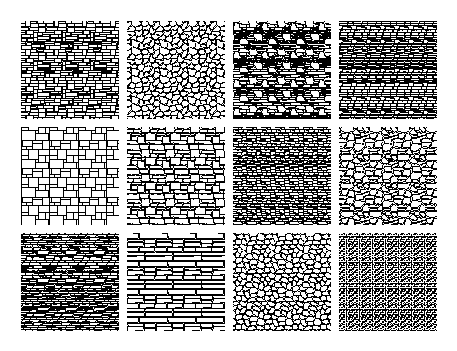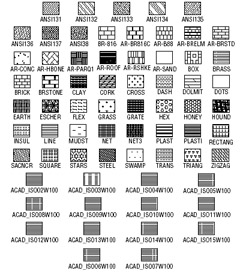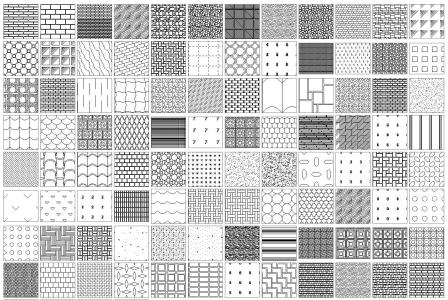

The delta-y value indicates the spacing between members of the family that is, it is measured perpendicular to the lines.
 The delta-x value indicates the displacement between members of the family in the direction of the line. Each pattern line is considered to be the first member of a line family, created by applying the delta offsets in both directions to generate an infinite family of parallel lines. Blank lines and text to the right of a semicolon are ignored. However, you must begin a pattern definition with a letter or number, not a special character. You can include letters, numbers, and the special characters underline (_), hyphen (-), and dollar sign ($). Each line in a pattern definition can contain up to 80 characters. Hatch pattern definitions follow these rules: This simple pattern definition specifies a line drawn at an angle of 45 degrees, the first line of the family of hatch lines is to pass through the drawing origin (0,0), and that the spacing between hatch lines of the family is to be 0.125 drawing units. The pattern name on the first line, *ANSI31, is followed by a description: ANSI Iron, Brick, Stone masonry. pat file of an existing hatch used in a drawing, use the express tool SUPERHATCH to try and bring in the custom hatch pattern.And is defined as follows: *ANSI31, ANSI Iron, Brick, Stone masonry It is usually the first one shown, pointing to the current user folder.
The delta-x value indicates the displacement between members of the family in the direction of the line. Each pattern line is considered to be the first member of a line family, created by applying the delta offsets in both directions to generate an infinite family of parallel lines. Blank lines and text to the right of a semicolon are ignored. However, you must begin a pattern definition with a letter or number, not a special character. You can include letters, numbers, and the special characters underline (_), hyphen (-), and dollar sign ($). Each line in a pattern definition can contain up to 80 characters. Hatch pattern definitions follow these rules: This simple pattern definition specifies a line drawn at an angle of 45 degrees, the first line of the family of hatch lines is to pass through the drawing origin (0,0), and that the spacing between hatch lines of the family is to be 0.125 drawing units. The pattern name on the first line, *ANSI31, is followed by a description: ANSI Iron, Brick, Stone masonry. pat file of an existing hatch used in a drawing, use the express tool SUPERHATCH to try and bring in the custom hatch pattern.And is defined as follows: *ANSI31, ANSI Iron, Brick, Stone masonry It is usually the first one shown, pointing to the current user folder.  The default path is specified in the Support File Search Path listed under the Files tab in Options. The AppData and Application Data folders in the above paths are hidden folders (see How to turn on hidden files and folders on Windows).
The default path is specified in the Support File Search Path listed under the Files tab in Options. The AppData and Application Data folders in the above paths are hidden folders (see How to turn on hidden files and folders on Windows).  For AutoCAD 2009 and earlier, the default location is: C:Program FilesAutodesk AutoCAD 20xxSupport. C:Documents and Settings Application DataAutodesk AutoCAD 20xxRxx.xSupport C:Users AppDataRoamingAutodesk AutoCAD 20xxRxx.xSupport pat files will cause hatches to be listed under the User Defined or Custom hatch menu within AutoCAD. pat files into the default Support folder (listed below) that AutoCAD uses to find hatch patterns.
For AutoCAD 2009 and earlier, the default location is: C:Program FilesAutodesk AutoCAD 20xxSupport. C:Documents and Settings Application DataAutodesk AutoCAD 20xxRxx.xSupport C:Users AppDataRoamingAutodesk AutoCAD 20xxRxx.xSupport pat files will cause hatches to be listed under the User Defined or Custom hatch menu within AutoCAD. pat files into the default Support folder (listed below) that AutoCAD uses to find hatch patterns.












